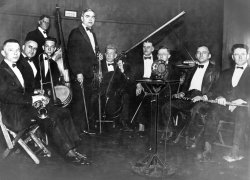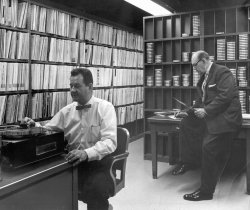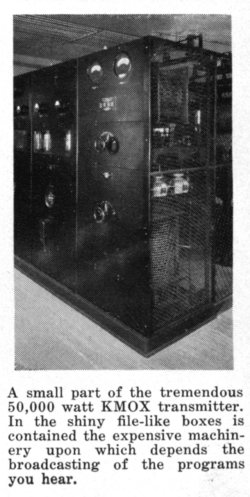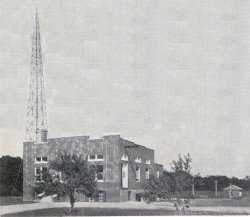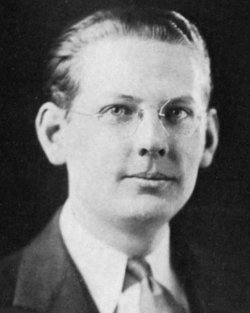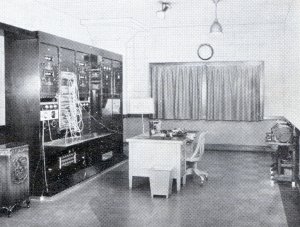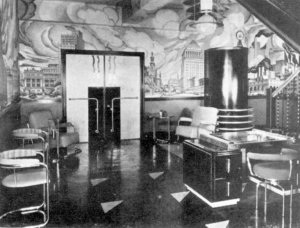Radio Articles
St. Louis Cardinals’ Radio History
For generations radio listeners have twisted their dials with renewed fervor in April when baseball season begins. It St. Louis for over a half-century, those dials were tuned to KMOX, but the Cardinals’ play-by-play has been heard on other stations here too.
St. Louis baseball was actually first heard on the radio in 1926 when the Cardinals were in the World Series. It was the club’s first appearance in the post-season classic, and play-by-play man Graham MacNamee’s voice was heard on a primitive network hookup originating at WEAF in New York and picked up in St. Louis on KSD. (A published report lists Lester Arthur Benson as the originator of baseball broadcasts in St. Louis, but there is no documentation to back this up.)
The next year Cardinals’ owner Sam Breadon granted permission for the team’s home games to be broadcast on the radio, and according to Curt Smith in the book “Voices of the Game,” Garnett Marks was the first local announcer to broadcast the Cardinals. The station was KMOX. It’s notable that Marks didn’t use his name during that first full season, instead calling himself “Rhino Bill” at the behest of his sponsor, Rhino Tire Stores. Midway through the season, his sponsor changed and so did his name, to Otto Buick.
KMOX didn’t have a monopoly on the broadcasts, but the station’s managing director, Thomas Patrick Convey, took credit for being the pioneer of local baseball broadcasts. The Globe-Democrat published an article in 1949 crediting Convey with originating “the first baseball broadcast from inside Sportsmen’s Park.”
The reality, in Convey’s own words in a letter written in May of 1929, was, “In March, 1926, as managing director of KMOX…I secured permission to install facilities in the press box…For two weeks in April, 1926, I sat in the press box and gave the scores, runs, hits and errors over the air. During the third and fourth weeks another employee of KMOX gave the score.
“…This broadcast was discontinued as the officials figured it was costing too much money.”
Over the years, announcers and stations changed:
| 1926 | KMOX | Thomas Patrick, Garnett Marks (partial season) |
| 1927 | KMOX | Garnett Marks (Rhino Bill, Otto Buick) |
| KFVE | Thomas Patrick | |
| WIL | William Elsworth | |
| 1928 | KMOX | Garnett Marks |
| KWK | Thomas Patrick | |
| WIL | William Elsworth | |
| 1929 | KMOX | France Laux |
| KWK | Thomas Patrick | |
| 1930 | KMOX | France Laux |
| KWK | Thomas Patrick | |
| WIL | L. A. Eddie Benson | |
| 1931 | KMOX | France Laux |
| KWK | Thomas Patrick | |
| WIL | L. A. Eddie Benson | |
| 1932 | KMOX | France Laux |
| KWK | Thomas Patrick, Johnny Harrington | |
| 1933 | KMOX | France Laux |
| KWK | Johnny Harrington, Thomas Patrick, Bob Thomas | |
| 1934 | KMOX | France Laux |
| KWK | Bob Thomas, Ray Schmidt | |
| 1935 | KMOX | France Laux |
| KWK | Johnny Harrington, Bob Thomas | |
| WIL | Neil Norman | |
| 1936 | KMOX | France Laux |
| KWK | Johnny O’Hara, Ray Schmidt | |
| 1937 | KMOX | France Laux, Jim Alt |
| KWK | Johnny O’Hara, Ray Schmidt, Allan Anthony, Tom Dailey | |
| 1938 | KMOX | France Laux, Ray Alt |
| KWK | Allan Anthony, Johnny O’Hara | |
| 1939 | KMOX | France Laux, Cy Casper |
| KWK | Johnny O’Hara, Jim Bottomley | |
| 1940 | KMOX | France Laux |
| KWK | Johnny O’Hara, Johnny Neblett | |
| KXOK | Alex Buchan, Ray Schmidt, Gabby Street | |
| 1941 | KWK | Johnny O’Hara, Johnny Neblett, Dizzy Dean |
| KXOK | France Laux | |
| 1942 | KWK | Dizzy Dean, Johnny O’Hara |
| KXOK | France Laux | |
| 1943 | KWK | Dizzy Dean, Johnny O’Hara |
| KXOK | France Laux, Ron Rawson | |
| 1944 | WEW(Day)/WTMV(Night) | Dizzy Dean, Johnny O’Hara |
| 1945 | WIL | Harry Caray, Gabby Street |
| WEW(Day)/WTMV(Night) | France Laux, Johnny O’Hara | |
| 1946 | WIL | Dizzy Dean, Johnny O’Hara |
| WEW/WTMV | Harry Caray, Gabby Street | |
| 1947 | WEW/WTMV | Harry Caray, Gabby Street |
| WIL | Dizzy Dean, Johnny O’Hara |
Following the 1947 season, Breadon announced the creation of a six-station radio network for the next year, meaning outlying stations would be carrying the same broadcasts heard in St. Louis, sponsored by Griesedieck Brothers’ Brewery.
| 1948 | WEW, WEW-FM/WTMV/KXOK-FM | Harry Caray, Gabby Street |
| 1949 | WIL, WIL-FM | Harry Caray, Gabby Street |
| 1950 | WIL | Harry Caray, Gabby Street, Stretch Miller |
| 1951 | WIL | Harry Caray, Gus Mancuso |
| 1952 | WIL | Harry Caray, Gus Mancuso, Stretch Miller |
| 1954 | KXOK | Harry Caray, Jack Buck |
| 1955 | KMOX | Harry Caray, Jack Buck, Joe Garagiola |
| 1960 | KMOX | Harry Caray, Joe Garagiola |
| 1961 | KMOX | Harry Caray, Jack Buck, Joe Garagiola |
| 1963 | KMOX | Harry Caray, Jack Buck, Jerry Gross |
| 1968 | KMOX | Harry Caray, Jack Buck |
| 1970 | KMOX | Jack Buck, Jim Woods |
| 1971 | KMOX | Jack Buck, Jim Woods |
| 1972 | KMOX | Jack Buck, Mike Shannon, Jim Walden |
| 1973 | KMOX | Jack Buck, Mike Shannon, Harry Walker |
| 1974 | KMOX | Jack Buck, Mike Shannon, Bob Starr |
| 1975 | KMOX | Jack Buck, Mike Shannon |
| 1976 | KMOX | Jack Buck, Mike Shannon, Bob Starr |
| 1980 | KMOX | Jack Buck, Mike Shannon, Dan Kelly |
| 1984 | KMOX | Jack Buck, Mike Shannon, Red Rush |
| 1985 | KMOX | Jack Buck, Mike Shannon |
| 1992 | KMOX | Jack Buck, Mike Shannon, Joe Buck |
| 1993 | KMOX | Jack Buck, Mike Shannon |
| 1994 | KMOX | Jack Buck, Mike Shannon, Joe Buck |
| 1995 | KMOX | Jack Buck, Mike Shannon, Joe Buck, Bob Carpenter |
| 1996 | KMOX | Jack Buck, Mike Shannon, Joe Buck |
| 2001 | KMOX | Jack Buck, Mike Shannon, Joe Buck, Dan McLaughlin |
| 2002 | KMOX | Mike Shannon, Joel Meyers |
| 2003 | KMOX | Mike Shannon, Wayne Hagin |
| 2006 | KTRS | Mike Shannon, John Rooney |
| 2011 | KMOX | Mike Shannon, John Rooney |
| 2013 | KMOX | Mike Shannon, John Rooney, Mike Claiborne, Rick Horton, Al Hrabosky |
| 2016 | KMOX | Mike Shannon, John Rooney, Mike Claiborne, Rick Horton |
| 2022 | KMOX | John Rooney, Mike Claiborne, Rick Horton |
(Reprinted with permission of the St. Louis Journalism Review. Originally published April, 05. Original article updated 2022)
